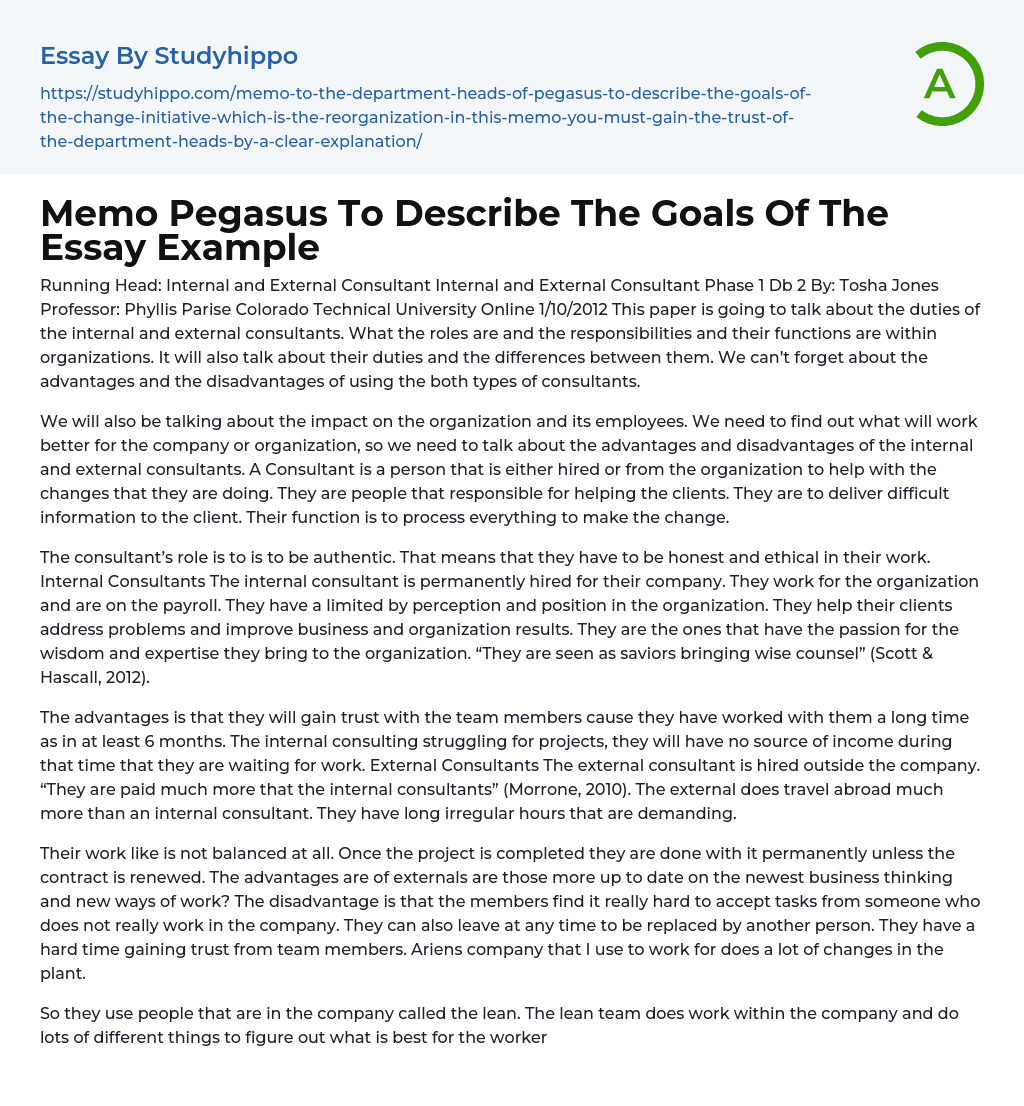Running Head: Internal and External Consultant
Internal and External Consultant Phase 1 Db 2
By: Tosha Jones
Professor: Phyllis Parise
Colorado Technical University Online
1/10/2012
This paper discusses the duties, roles, responsibilities, and functions of both internal and external consultants within organizations.
This text will analyze the responsibilities of consultants and compare internal and external consultants, evaluating the advantages and disadvantages of each. It will also assess the impact that these types of consultants have on the organization and its employees. To make an informed decision for a company or organization, it is essential to thoroughly consider both the benefits and drawbacks of internal and external consultants.
The responsibility of a Consultant, whether hired externally or internally, is to facilitate and support changes within the organization. Their role involves delivering challenging information to clients and
...undertaking all necessary steps for a successful transformation.
The consultant's responsibility is to be genuine, which entails being truthful and ethical. Internal consultants, who are permanent employees of their company and receive regular wages, have a limited perspective due to their perception and position within the organization. Their primary role is to assist clients in resolving issues and enhancing business and organizational outcomes.
According to Scott ; Hascall (2012), internal consultants are valued for the wisdom and expertise they bring to an organization and are often seen as saviors who provide wise counsel. One advantage of internal consultants is that they can build trust with team members due to their long-term working relationships, typically lasting at least 6 months. However, internal consultants may face challenges in finding projects and may have no source of income while waiting for work.
On the other hand, external consultants are hired from outside the company.
Morrone (2010) states that external consultants are paid significantly more than internal consultants.
The external consultant travels abroad more often than an internal consultant. Their working hours are long and irregular, creating demanding conditions. Their work-life balance is nonexistent. Once a project is finished, they move on from it permanently unless the contract is renewed. The benefits of hiring external consultants include their knowledge of the latest business trends and innovative work methods. However, a drawback is that team members may struggle to accept assignments given by individuals who are not part of the company. Additionally, external consultants can leave at any time, potentially being replaced by someone new.
The Ariens company, my former workplace, is struggling to build trust among their team members. To address this issue, they have introduced a program called "the lean" that aims to bring about several changes in the plant. The lean team is tasked with assessing different aspects of the company to identify what would be beneficial for both the employees and the organization as a whole. The primary objective of the lean program is to enhance productivity by implementing efficient modifications on the production lines.
A group of workers collaborate to generate ideas for enhancing the workspace and increasing productivity. Their main goal is to implement changes in a safe and responsible way. These individuals are paid for their time spent collectively devising strategies that will benefit the company, its employees, and prioritize safety. Hiring a consultant has various benefits including their specialized expertise, flexible arrangements, tax contributions, utilizing their services as needed, and easily terminating their contract compared to employees.
There are several drawbacks to this situation. Initially, consultants may
not offer the same level of relationship continuity as employees do. Additionally, they might be required to pay high fees for their services. Moreover, there is a limited amount of control over consultants and a potential risk of tax issues if they are labeled as employees (All Business.com, 2004). References: Scott, B.
, ; Hascall, J. (2012). Inside or outside: Internal and external consultants. Retrieved from http://bevscott.
com/InsideorOutside.pdf Morrone, A. (2010, February 6). External versus internal consulting. Retrieved from http://www.
Examiner.com/workplace-in-chicago/external-versus-internal-consulting All Business.com. (2004, Dec 13). The advantages and disadvantages of employing consultants.
Source: http://www.allbusiness.com/human-resources/workforce-management-hiring-consulting/1655-1.html
- Goal Setting essays
- Accomplishment essays
- American Dream essays
- Barriers To Entry essays
- Capitalism essays
- Central Bank essays
- Compensation essays
- Consumerism essays
- Economic Development essays
- Economic Growth essays
- Economic Inequality essays
- Economic System essays
- Economy essays
- Employment essays
- Export essays
- Finance essays
- Free Trade essays
- Gross Domestic Product essays
- Human Development essays
- Income Inequality essays
- Industry essays
- Inflation essays
- International Business essays
- International Trade essays
- Macroeconomics essays
- Materialism essays
- Max Weber essays
- Microeconomics essays
- Minimum Wage essays
- Monetary Policy essays
- Monopoly essays
- Pricing essays
- Profit essays
- Recession essays
- resources essays
- Taxation essays
- Trade essays
- Unemployment essays
- Warehouse essays
- World economy essays
- Attitude essays
- Goals essays
- Personal Goals essays
- Personal Life essays
- Personality essays
- Principles essays
- Reputation essays
- Self Awareness essays
- Self Esteem essays
- Self Reflection essays




